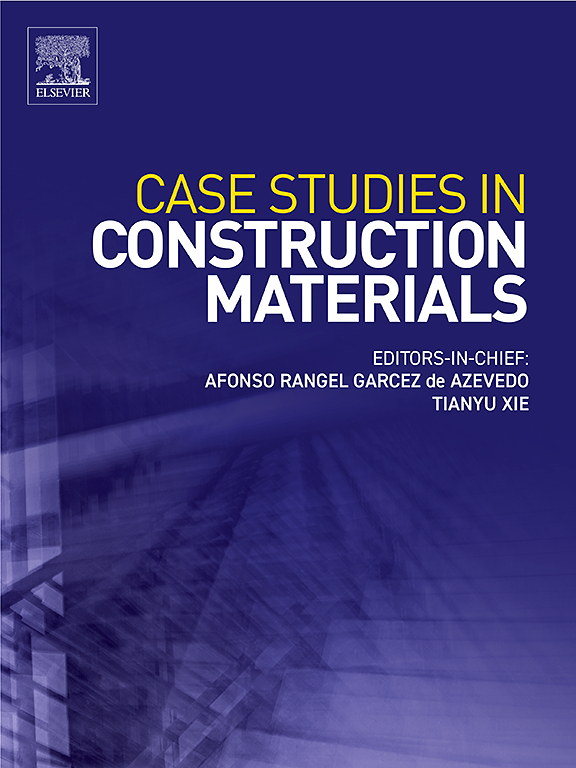Steel fiber-reinforced slag-based concretes for floats of FOWTs – The case of a slab as a preliminary approach: design, durability under chloride exposure and Life Cycle Assessment
IF 6.6
2区 工程技术
Q1 CONSTRUCTION & BUILDING TECHNOLOGY
引用次数: 0
Abstract
Concrete Floating wind turbine is a solution of the future for Marine Renewable Energies (MRE). The B2FE project, i.e., steel fiber-reinforced concrete (SFRC) for wind turbine floats, aims at developing and characterizing a slag-based concrete (low-carbon concrete) reinforced with steel fibers (slag-based SFRC). Four concrete formulations composed of 50 % CEM I and 50 % blast furnace slag, including fiber contents of 0 (i.e., no fiber), 20, 40 and 60 kg.m−3, are studied. A simplified case study is investigated by considering a slab under the same exposure conditions as a FOWT. Considering given mechanical requirements (distributed load of 100 kPa, i.e. 10 t.m−2), the dimensioning of the slab is carried out with, on one hand, the slag-based RC solution (no fiber) and on the other hand, the three SFRC formulations (no rebar). Compared to steel bar reinforcements, it appears that steel fibers can provide similar mechanical properties with fewer concrete or steel which is a very interesting result. Then, knowing the physicochemical properties of the materials, simulations of chloride ions transport in the slab subjected to sea water tidal conditions (known as much "aggressive" as splashing) are performed to estimate the service life of these solutions: they appear to be around 30 years, which meet the expectations. Finally, a cradle-to-gate Life Cycle Analysis (LCA) demonstrates a clear advantage of fiber-reinforced formulations, by reducing carbon footprint and other indicators of environmental impacts. In terms of service life and carbon footprint, an innovative cross-analysis leads to an optimal steel fiber content of 40 kg.m−3.
浮筒用钢纤维增强渣基混凝土。以板为初步方法的案例:设计、氯化物暴露下的耐久性和生命周期评估
混凝土浮动风力涡轮机是未来海洋可再生能源(MRE)的解决方案。B2FE项目,即用于风力涡轮机浮子的钢纤维增强混凝土(SFRC),旨在开发和表征用钢纤维(渣基SFRC)增强的渣基混凝土(低碳混凝土)。由50% % CEM I和50% %高炉渣组成的四种混凝土配方,其中纤维含量分别为0(即无纤维)、20、40和60 kg。研究了M−3。通过考虑与FOWT相同暴露条件下的平板,研究了一个简化的案例研究。考虑到给定的力学要求(分布荷载为100 kPa,即10 t.m−2),板的尺寸计算一方面采用渣基RC溶液(无纤维),另一方面采用三种SFRC配方(无钢筋)。与钢筋加固相比,钢纤维似乎可以用更少的混凝土或钢来提供类似的机械性能,这是一个非常有趣的结果。然后,了解材料的物理化学性质,模拟氯离子在受海水潮汐条件(被称为“侵略性”飞溅)影响的板中的传输,以估计这些溶液的使用寿命:它们似乎在30年左右,符合预期。最后,从摇篮到门的生命周期分析(LCA)表明,通过减少碳足迹和其他环境影响指标,纤维增强配方具有明显的优势。在使用寿命和碳足迹方面,创新的交叉分析导致最佳钢纤维含量为40 kg.m−3。
本文章由计算机程序翻译,如有差异,请以英文原文为准。
求助全文
约1分钟内获得全文
求助全文
来源期刊

Case Studies in Construction Materials
Multiple-
CiteScore
7.60
自引率
19.40%
发文量
842
审稿时长
63 days
期刊介绍:
Case Studies in Construction Materials provides a forum for the rapid publication of short, structured Case Studies on construction materials. In addition, the journal also publishes related Short Communications, Full length research article and Comprehensive review papers (by invitation).
The journal will provide an essential compendium of case studies for practicing engineers, designers, researchers and other practitioners who are interested in all aspects construction materials. The journal will publish new and novel case studies, but will also provide a forum for the publication of high quality descriptions of classic construction material problems and solutions.
 求助内容:
求助内容: 应助结果提醒方式:
应助结果提醒方式:


